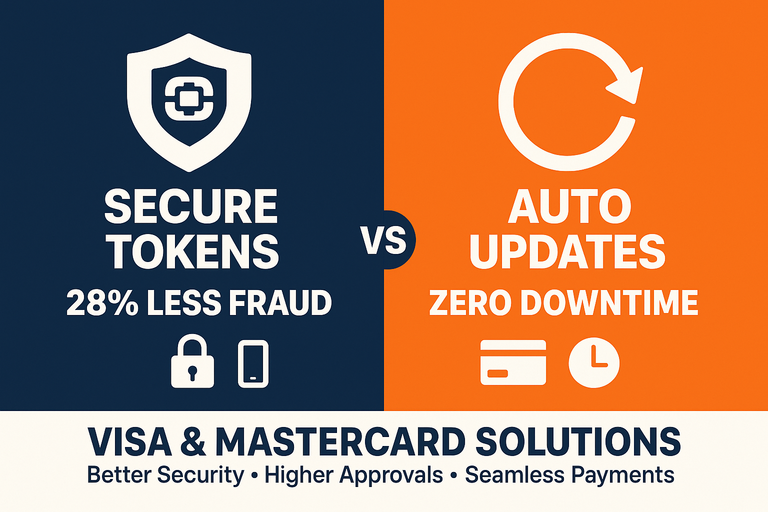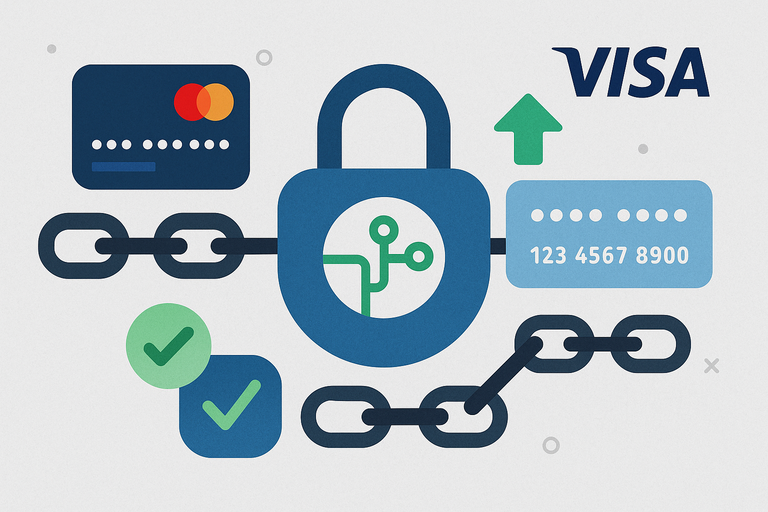Why Network Tokens Win
Network tokenization is revolutionizing digital payments by boosting authorization rates while enhancing security. This blog post explores how replacing static card data with dynamic network tokens helps reduce false declines, supports seamless recurring payments, and improves cross-border transaction success. Learn why this technology is becoming critical for payment providers aiming to stay competitive.

Tokenize to Authorize: Why Network Tokens Are the Key to Higher Approval Rates
Network tokenization has emerged as a game-changing technology for payment providers, offering a compelling solution to one of the industry's most persistent challenges: improving authorization rates while maintaining robust security. As digital payments continue to evolve, understanding how network tokenization directly impacts authorization success rates has become critical for executives across the payments ecosystem.
Understanding Network Tokenization and Its Authorization Impact
Network tokenization represents a fundamental shift from traditional payment processing methods. Unlike conventional approaches where sensitive card data travels through multiple touchpoints, network tokenization replaces the primary account number (PAN) with a unique digital identifier called a token, generated directly by the card networks themselves16. This token maintains the same length and format as the original PAN, ensuring seamless integration with existing payment infrastructure while providing enhanced security and, crucially, improved authorization rates.
The authorization rate improvement stems from several key factors inherent to network tokenization. When a payment request uses a network token, it signals to the issuing bank that the transaction has already undergone additional security verification by the card network6. This enhanced trust factor significantly reduces the likelihood of false declines, which are particularly problematic in card-not-present transactions that are five times more likely to be flagged as fraudulent compared to card-present transactions8.
Network tokens also include unique transaction cryptograms that provide additional authentication data with each transaction6. These cryptograms serve as dynamic security elements that validate the authenticity of each payment request, giving issuers greater confidence in approving transactions. This technological approach addresses the fundamental tension between security and user experience that has historically plagued digital payments.
The Scale and Growth of Network Tokenization
Recent market data underscores the rapid adoption and projected growth of network tokenization. According to Juniper Research, network tokenized transactions are forecast to reach 574 billion globally by 20293. This exponential growth reflects not only the technology's security benefits but also its proven impact on authorization rates and overall payment performance.
Mastercard has made particularly aggressive commitments to tokenization adoption, announcing its vision to achieve 100% e-commerce tokenization in Europe by 20302. This initiative aims to phase out manual card entry entirely, replacing traditional 16-digit card numbers with secure tokens across all online transactions. The scope of this commitment demonstrates the card networks' confidence in tokenization's ability to simultaneously enhance security and improve transaction success rates.
Network Tokenization vs. Vault-Based and Gateway Tokenization
Understanding the distinctions between network tokenization and traditional tokenization methods is essential for payment providers evaluating their technology stack. While all tokenization approaches aim to protect sensitive payment data, they differ significantly in their impact on authorization rates and operational efficiency.
Gateway Tokenization Limitations
Gateway tokenization, also known as vault tokenization, involves payment service providers creating tokens to replace sensitive card data within their own systems57. When a customer initiates a transaction, their payment information travels to the payment provider, where it triggers the creation of a payment profile stored on PCI-compliant servers. A token is generated and sent back to the merchant for future use7.
However, this approach has inherent limitations for authorization rates. The token created by the gateway is only meaningful between the merchant and their payment provider7. Once the transaction reaches the card network or issuing bank, the original card data must be used for authorization, eliminating many of the trust signals that could improve approval rates. Additionally, gateway tokenization cannot automatically handle card updates, leading to increased decline rates when cards expire or are reissued.
Network Tokenization Advantages
Network tokenization addresses these limitations by involving the card networks directly in the token creation process. Visa Token Service and Mastercard's equivalent systems generate tokens at the network level, ensuring that the token remains valid throughout the entire payment ecosystem16. This approach provides several authorization rate benefits that gateway tokenization cannot match.
First, network tokens automatically receive updates when underlying card information changes7. If a customer's card expires or is reissued, the network token automatically reflects these updates without requiring any action from the merchant or customer. This capability alone significantly reduces decline rates associated with outdated card information, which represents a substantial portion of false declines in recurring payment scenarios.
Second, network tokenization provides enhanced authentication signals to issuers. The presence of a network token indicates that the transaction has undergone additional verification steps by the card network, creating a higher confidence level for authorization decisions6. Combined with the unique transaction cryptograms generated for each payment, these signals help issuers distinguish between legitimate transactions and potential fraud attempts more accurately.
Comparative Impact on Authorization Rates
The authorization rate improvements from network tokenization versus gateway tokenization are substantial and measurable. While gateway tokenization primarily provides security benefits through data protection, network tokenization delivers both security and performance enhancements. The automatic credential updating feature alone can improve authorization rates by 2-4% for merchants with significant recurring payment volumes, as it eliminates declines due to expired or updated card information.
Network tokenization also reduces false declines across all transaction types, not just recurring payments. The enhanced authentication signals and network-level verification help issuers make more informed authorization decisions, particularly for card-not-present transactions where fraud concerns traditionally lead to higher decline rates.
Real-World Impact and Implementation Examples
The practical benefits of network tokenization for authorization rates are evident across various payment scenarios and merchant types. For subscription-based businesses, the technology has proven particularly transformative in addressing the persistent challenge of involuntary churn due to payment failures.
Subscription and Recurring Payment Success
Subscription merchants typically experience authorization rates 15-25% lower than one-time transaction merchants due to the absence of active customer participation in recurring billing cycles7. Network tokenization directly addresses this challenge through its automatic credential updating capabilities. When a customer's underlying card information changes, the network token seamlessly reflects these updates, ensuring continued payment success without customer intervention.
Consider a streaming service processing millions of monthly subscriptions. Before network tokenization implementation, approximately 3-5% of recurring payments would fail due to expired or updated card credentials. With network tokenization, these unnecessary failures are virtually eliminated, translating to significant revenue recovery and improved customer retention. The technology's impact extends beyond immediate authorization improvements to long-term customer lifetime value optimization.
E-commerce and Digital Wallet Integration
The e-commerce sector has seen substantial authorization rate improvements through network tokenization, particularly when integrated with digital wallet solutions. Mastercard's commitment to 100% e-commerce tokenization in Europe by 2030 includes strategic partnerships with banks and fintechs to embed Click to Pay functionality directly into merchant checkout experiences2. This integration eliminates manual card entry while leveraging network tokenization's authorization benefits.
Early implementations of this technology have demonstrated measurable improvements in both authorization rates and checkout completion rates. The combination of reduced friction and enhanced authentication signals creates a virtuous cycle where improved user experience leads to higher conversion rates, while better authorization rates reduce revenue loss from false declines.
Cross-Border and High-Risk Transaction Processing
Network tokenization has shown particular promise in improving authorization rates for traditionally challenging transaction types, including cross-border payments and transactions in higher-risk merchant categories. The enhanced authentication signals provided by network tokens help issuers differentiate between legitimate international transactions and potentially fraudulent cross-border activity.
Payment providers serving global markets have reported authorization rate improvements of 3-7% for cross-border transactions when using network tokenization compared to traditional card processing. These improvements are particularly significant given the typically higher decline rates associated with international payment processing.
Technical Implementation Considerations for Payment Providers
For payment providers evaluating network tokenization implementation, understanding the technical requirements and integration pathways is crucial for successful deployment. The technology requires coordination between multiple stakeholders in the payment ecosystem, but the infrastructure investments yield substantial long-term benefits for authorization performance.
Integration Architecture and Requirements
Network tokenization implementation typically involves direct integration with card network token services, including Visa Token Service Provisioning and Credential Management APIs1. These APIs provide flexible and scalable methods for issuing tokens and managing their lifecycle across e-commerce, mobile commerce, in-app, and contactless purchase scenarios.
The integration architecture must accommodate token provisioning, transaction processing with tokens, and credential lifecycle management. Payment providers need to implement systems capable of handling token requests, managing the relationship between tokens and underlying card data, and processing the unique cryptograms associated with each tokenized transaction6.
Successful implementation also requires careful attention to token requestor registration and certification processes with each card network. Payment providers must establish themselves as certified token requestors, meeting specific security and operational requirements defined by Visa, Mastercard, and other networks they plan to support.
Operational Benefits and Challenges
Beyond authorization rate improvements, network tokenization offers operational benefits that extend throughout the payment provider's infrastructure. The technology reduces PCI compliance scope by minimizing the handling and storage of sensitive card data4. When payment information is tokenized at the network level, payment providers can process transactions without directly handling primary account numbers, significantly reducing their PCI burden.
However, implementation does present certain challenges that require careful planning. Token lifecycle management becomes more complex, requiring systems to track token status, handle token updates, and manage the relationship between multiple tokens that may exist for a single underlying card. Payment providers must also implement robust monitoring and reporting capabilities to track token performance and authorization rate improvements.
The technology's benefits compound over time as token adoption increases across merchant portfolios. Early implementations may show modest authorization rate improvements that grow significantly as more transactions leverage network tokens instead of traditional card processing methods.
Future Outlook and Strategic Considerations
The trajectory of network tokenization adoption suggests that payment providers who delay implementation may find themselves at a competitive disadvantage in authorization performance. As card networks continue investing in tokenization infrastructure and issuers become more familiar with token-based authentication signals, the authorization rate benefits are likely to increase further.
Market Dynamics and Competitive Positioning
Mastercard's commitment to achieving 100% e-commerce tokenization in Europe by 2030 represents more than an aspirational goal—it signals a fundamental shift in how card networks envision the future of digital payments2. Payment providers that position themselves early in this transition will benefit from competitive advantages in authorization rates, potentially allowing them to offer more attractive pricing and performance guarantees to their merchant clients.
The projected growth to 574 billion network tokenized transactions globally by 2029 indicates massive market opportunity for payment providers with robust tokenization capabilities3. This growth trajectory suggests that tokenization proficiency will become a table-stakes requirement rather than a differentiating feature, making early implementation crucial for maintaining competitive positioning.
Regulatory and Industry Evolution
The regulatory environment increasingly favors technologies that enhance payment security without compromising user experience. Network tokenization aligns with these regulatory trends while providing measurable business benefits through improved authorization rates. As data protection regulations continue evolving globally, the technology's ability to reduce sensitive data exposure while improving transaction performance positions it as a strategic investment for payment providers.
Industry standards and best practices around tokenization continue maturing, with card networks providing increasingly sophisticated APIs and integration tools. Payment providers that engage early in this evolution can influence standard development while building expertise that will prove valuable as tokenization becomes ubiquitous.
BetterCharge's Perspective on Network Tokenization
As the payments industry continues evolving toward more secure and efficient transaction processing methods, network tokenization represents a significant technological advancement that addresses multiple industry challenges simultaneously. The technology's ability to improve authorization rates while enhancing security makes it particularly relevant for payment providers seeking to optimize their service offerings.
For payment providers evaluating tokenization strategies, the authorization rate benefits of network tokenization compared to alternative approaches warrant serious consideration. The technology's impact on false decline reduction, automatic credential updating, and enhanced issuer confidence creates measurable value that extends beyond security improvements to tangible business outcomes.
The implementation complexity and technical requirements associated with network tokenization are substantial but manageable for organizations with appropriate technical resources and strategic commitment. The long-term benefits in authorization performance, competitive positioning, and operational efficiency make the technology investment strategically sound for payment providers serving digital commerce markets.
Conclusion
Network tokenization has proven its value as more than just a security enhancement—it represents a fundamental improvement in payment authorization performance that benefits the entire payments ecosystem. The technology's ability to reduce false declines, automatically manage credential updates, and provide enhanced authentication signals creates measurable improvements in authorization rates across various transaction types and merchant categories.
For payment providers, the strategic imperative extends beyond the immediate benefits of improved authorization rates. As card networks commit to comprehensive tokenization adoption and the market evolves toward token-based processing as the standard, early implementation provides competitive advantages that compound over time. The technology's proven impact on authorization performance, combined with its security benefits and operational efficiencies, makes network tokenization an essential component of modern payment infrastructure.
The evidence from market leaders like Mastercard and Visa, combined with industry projections showing massive growth in tokenized transactions, demonstrates that network tokenization represents the future direction of digital payments. Payment providers that embrace this technology early will be better positioned to serve their merchant clients with superior authorization performance while building the infrastructure necessary for long-term success in an increasingly token-based payments landscape.


